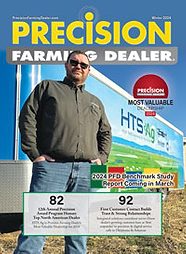An evolving ISOBUS-certified equipment database and a new field diagnostic test could add sales and service value for dealers.
Many precision specialists note that brand purity isn’t often a priority when customers invest in farm technology. Farmers want products that work, and increasingly, different brands of products that work together, without sacrificing performance or efficiency.
Although the ISOBUS 11783 standard has been around for nearly 15 years, only recently have manufacturers made a concerted effort to work together on improving equipment compatibility.
“It’s because the customer is starting to understand the technology better and they are putting more pressure on manufacturers to come up with solutions,” says Ryan Pilot, engineering manager with Agtron Enterprises in Saskatoon, Saskatchewan. “There’s no sense having a high-end system if it all it does is look good or have a touchscreen. Farmers want the mapping, the steering; they want it all to work together.”
Several equipment manufacturers shared the same view with Precision Farming Dealer at the Agricultural Electronics Industry Foundation’s (AEF) Plugfest event held in Lincoln, Neb., on May 6-9.
The bi-annual gathering allows nearly 150 agricultural engineers from dozens of companies to analyze precision component compatibility through a standardized conformance test. The goal is to achieve ISOBUS certification in conjunction with AEF compatibility guidelines.

Achieving true “plug-and-play” functionality is the end goal for ag engineers, aided by a developing ISOBUS database and compatibility Check Tool.
While Pilot and other industry professionals say true “plug-and-play” capability is still likely several years away, two new AEF tools could improve precision dealers’ ability to research and solve compatibility problems.
By the end of the year, dealers will be able to work with manufacturers to access the AEF database of ISO-compatible equipment. This will allow dealers to quickly match functionality of tractors and implements, says Andrew Olliver, from the AEF communications and marketing group.
“This will be a useful sales tool for dealers, especially when a customer has one brand of tractor and is looking to purchase another brand of implement,” Olliver says. “If a farmer has a New Holland or Case IH tractor and wants to buy a Horsch planter or an AGCO baler, the dealer will be able to quickly log onto the database and check the combined functionality for the customer.”
Initial access to the database will be to one individual at the dealership, who can then grant access to additional employees, including precision specialists and technicians.
As the database is rolled out to dealers, training them on how to maximize its value is another element that will be addressed, Olliver says. The AEF is offering online sessions to train manufacturers; the onus is then on each manufacturer to train their dealers in advance of the rollout.

More than 50 different companies gathered in Lincoln, Neb., for the AEF Plufgest event in May to test compatibility of equipment components.
Precision technicians will also have the opportunity to run automatic in-field compatibility checks on equipment with a software tool that is connected to the AEF database.
“The technician can plug into the ISOBUS system and run a software program downloaded from the database called ISOBUS Check Tool to interrogate all the electronic control units (ECU) to create a log file,” Olliver says. “If a technician is out in the field and has an ISOBUS issue, he’ll be able to run this check tool and determine if the tractor and implement aren’t working together.”
If there’s not a quick fix, the technician can then open up a support ticket with the equipment manufacturers, via the AEF ISOBUS database and attach the diagnostic file.
“The beauty is that by having that diagnostic ticket and the details of the problem, it makes it a lot easier to start the diagnostic process,” Olliver says. “The dealer is really going to benefit from this tool because it’s a timesaver in the field to get faster resolution of compatibility problems.”



![[Technology Corner] Future of Drone Use in U S Brighter After FAA Regulation Change](https://www.precisionfarmingdealer.com/ext/resources/2024/04/11/4-12-24-Slides_OTR14.jpg?height=290&t=1712932011&width=400)



Post a comment
Report Abusive Comment